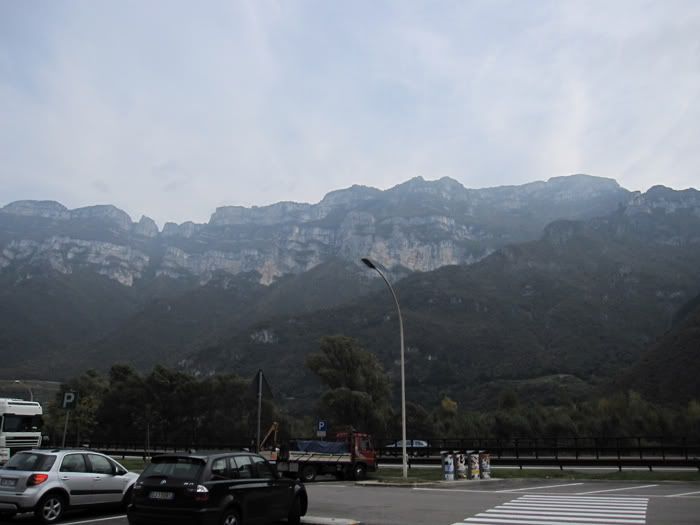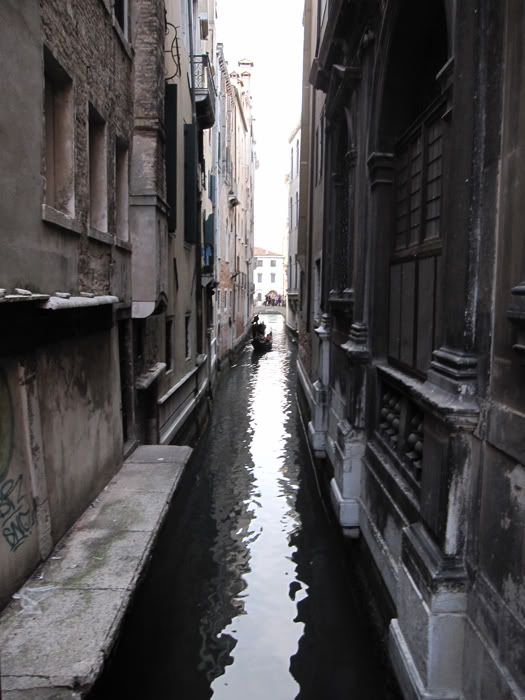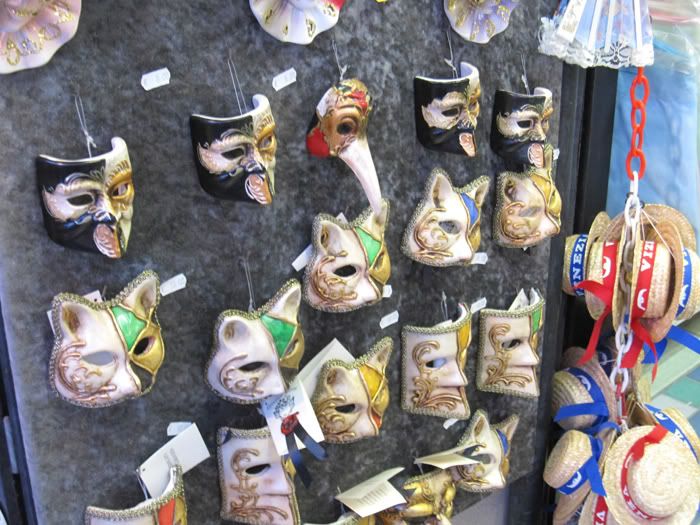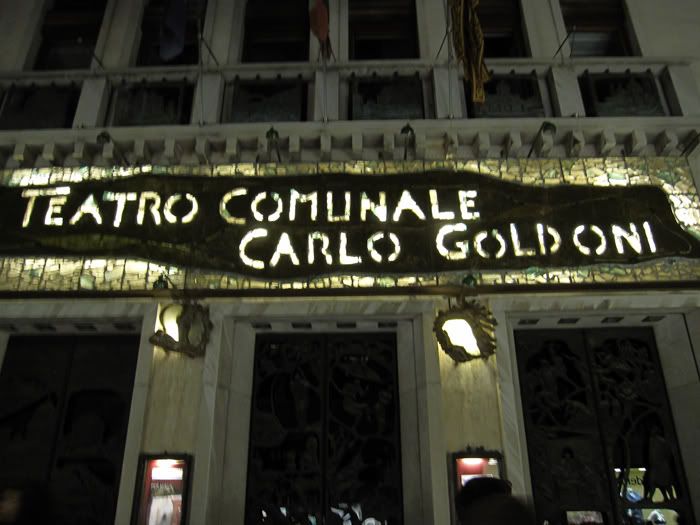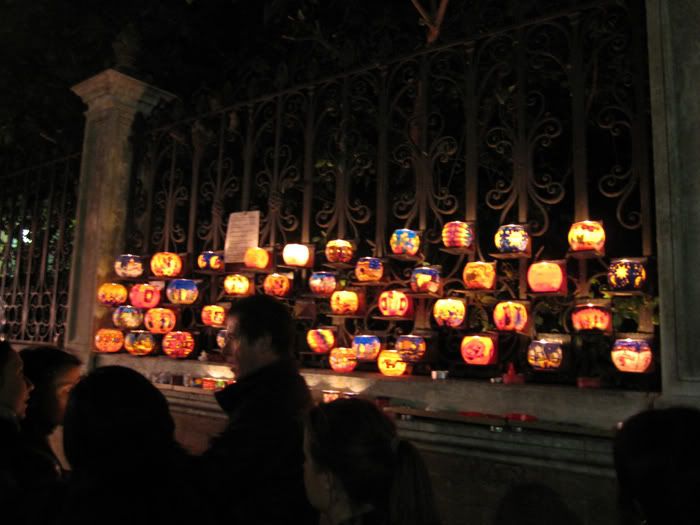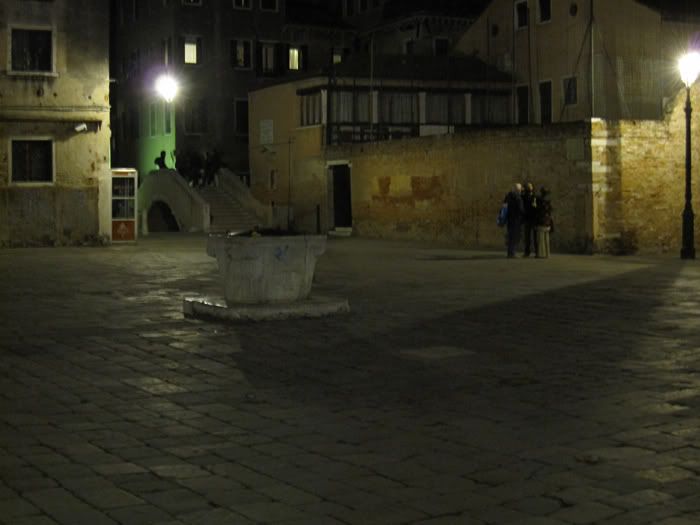This post recaps my Halloween 2009, which saw me halfway into a two-week tour of Europe. It was my first introduction to Italy, as I entered via Brenner Pass and the Dolomites, and headed for the famed water city of Venice. Italy became the seventh European country I get to check off.
As noted in the Day 6 recap, I ended up not visiting any of the salt mines near Salzburg. I simply took the shortest route out to Autobahn 1, then headed west back into Germany; even though the approach to Brenner Pass is via Innsbruck in western Austria, it is actually faster to dip briefly into Germany, due to lack of Autobahn connections between Salzburg and Innsbruck. After driving on German Autobahn 8 toward Munich for about 30 minutes, I found the Autobahn 93 turn-off, with clearly marked "I" oval, denoting access to Italy.
Autobahn 93 followed up the course of the Inn River, and before long, took me back into Austria, becoming Austrian Autobahn 12. Surrounded by old castles and snow-capped Alpine peaks, I made sure to enjoy the drive to the fullest. The CD player played the soundtrack to The Sound of Music movie from 1965, and I followed up with my modern-day favorite from back in California, Anna Nalick.
I am now taking a brief toilet break in Innsbruck, as Autobahn 13 splits off from the 12 to climb up the Brenner Pass and take me to Italy.
Innsbruck ("Bridge on the Inn River") is a very scenic town, best known as a ski resort, particularly attractive to those who live in countries without steep mountains (think England and the Netherlands). Unfortunately, between my need to continue to Venice and the difficulties I would certainly experience driving into town and parking, this will be all the Innsbruck I end up experiencing. Having to mind my mother's constant concerns regarding possible damage to the car is really piling on my stress level.
And here is an obligatory shot of the car against the Alpine peaks.
Austria has the strictest motorist regulations among the countries I am driving in. In addition to a toll sticker for the Autobahn system, I am also required to carry a safety vest inside the passenger compartment, to be worn in case of a roadside emergency; the vest was provided free of charge by Mercedes-Benz back in Sindelfingen. And more importantly, I am required to use winter tires between November and April, but that is also taken care of, since (1) I am leaving Austria for good on this October 31st, and (2) this car's all-season tires, thanks to their Mud + Snow designation, meet the requirement. Austrian driving in the winter on performance summer tires is not only dangerous, it is outright illegal, with a fine of €5,000.
Brenner Pass is only 30 minutes from Innsbruck, but in order to drive this short distance, I am required to pay a supplemental toll of €8 in cash on top of the toll sticker. Before long, the obligatory border slowdown took place, and in the midst of outlet stores, I could see a sign - European Union flag with the word "ITALIA" in the middle. I entered Italy. Shortly following were the default speed limit sign, showing Italian speed limits at 50 km/h urban, 90 rural, 110 on blue-signed free motorways, and 130 on green-signed toll motorways (Autostrada); the days of German-style unlimited Italian autostrade were long gone.
The initial drive through the rugged terrain was kept at 110 km/h, despite being a green-signed Autostrada. This 110 would persist throughout my drive on Autostrada 22 (the Italian extension of Austrian Autobahn 13). Soon, a toll booth issued me a magnetic toll ticket; Italian autostrade use a thruway-type toll collection system using tickets or transponders.
Autostrada 22 heads south from the Brenner Pass, through the lovely, rugged Dolomite Mountains, known for their stunning marble cliffs like this photo. This photo is just a tiny hint of all the gorgeous cliffs I could spot while driving, but couldn't photograph due to my need to put driving first. This photo is from a rest stop about 30 minutes north of Verona, where I would take the eastbound Autostrada 4 toward Venice (marked as Venezia on signs).
Up to this point, I am in the region known as Alto Adige, and as this region is historically populated by the Germanic people, all placenames have Italian and German versions, and all road signs and messages are in both Italian and German. Indeed, I am reminded that back when Germany's national anthem was sung as "Deutschland über alles," its lyrics included the phrase "From the Meuse to the Memel, From the Adige to the Belt" - a swath of territory that is now lost through losses in two World Wars. The Brenner Pass has historically connected this region to the rest of the Germanic world, and this road is dotted with castles - tollbooths back in the day, complete with accommodations for tolljumpers.
But make no mistakes, this is Italy. I am actually finding the Autostrada system to be better built and maintained than the German Autobahns; thanks to the nicer Italian climate, the road surfaces are in even better shape than the already excellent ones in Germany. Aside from acceleration and deceleration lanes which are mere afterthoughts drawn onto the shoulder, the autostrada is built to higher standards than the autobahn.
But I have to say that the real reminder of Italy comes from the reckless drivers. In Germany, I could count on all drivers obeying the strict regulations, such as no-passing-on-right and adherence to any mandatory speed limits. But here in Italy, I am finding that traffic regulations were meant to be ignored. Speeding and lane changes without signaling were very common, and while passing on the right was nowhere near the epidemic levels I see in California, I could still occasionally see it. I could also count on a mad flash of the high beams from behind if I did not vacate the fast lane in a microsecond, and a frustrated honk if I decided to treat stop signs (i.e. at this rest stop) as a full stop rather than a California stop.
I found that the worst a-holes on Italian autostrade were Audi drivers, filling in the niche occupied by BMW drivers in California. The worst slowpokes, just like in California, were Toyota drivers. Van drivers, be it the Central American theocrats in California driving a Chevrolet Astro, or brutes in South Korea driving a Hyundai Starex, used to push my buttons a lot, but they are less of a factor in Europe; the Astro is nonexistent, and drivers of the Starex and similar vans are well-behaved in Europe (aside from an occasional tendency to speed). Another demographic that used to push my buttons in South Korea - drivers of Ssangyong SUVs - also drove pretty well in Europe.
I refueled at this rest stop before continuing my way. Italian gas prices are similar to Austrian levels and much cheaper than German levels; I could expect to pay €1.00 per liter, and I only needed to pay for regular unleaded, which was already 95 octane (91 US octane), making premium at 98 octane a useless splurge. While Autostrada 22 continues south to Modena, home of Ferrari, I was more than happy to transfer to eastbound Autostrada 4 once in Verona, enjoying its 3 lanes all the way to Venice as well as consistent 130 km/h speed limit. It went through a flatter landscape surrounded by rolling hills, farms, and even an American military base. As I approached Venice, I stumbled into a "KARTE" lane at the toll booth, and paid with a debit card; the toll came out to be €21, definitely not cheap, and I had intended to pay at a cash lane, whose money icon I couldn't recognize right away. (Good thing I didn't use the TELEPASS lane for transponders.) Thanks to European distances being delightfully short and motorway speeds being fast, I arrived in Venice ahead of schedule - something that happened on every major driving day for me.
Once in Venice, I proceeded through Mestre before getting on the 2.5-mile Liberty Causeway to the water city itself. I parked at the enormous Tronchetto Garage, which I appreciated for its American-scale ramps and parking spaces, and fumbled my way to the vaporetto (water bus) stop, for a ride on the No. 2 water bus to Rialto Bridge. My mother was thinking "Harlem slum style decay" rather than "a former powerhouse" as the water bus made its way into the Grand Canal, and upon reaching Pensione Guerrato (Rick Steves' favorite hotel) and finding that the €130/night room I had booked was an attic room above fourth floor (sixth floor if counted American style) with no television, she was fuming. I fumed right back too, telling her to shove it with her Asian-American model minority materialism and excess. This trip was at its breaking point.
Cooler heads eventually prevailed, as I gladly let my mother know that I've myself been let down by another European city that other visitors rave about - namely, Amsterdam and its Surinamese thugs. Now the goal has become salvaging the Venice experience somehow, even if Venice falls way short of the sanitized/romanticized depictions in the movies and as seen at the Venetian Hotel and Casino in Las Vegas.
From the hotel near the Rialto Bridge, we are walking in the general direction of "Piazza San Marco" (St. Mark's Square). And every time a pedestrian path goes over a water canal, I am treated to views like this, an alleyway accessible only by water, served by a gondola. The path crosses the canal in the form of an elevated bridge, with a few steps up and down on either side, and that gets tiring after a while walking around Venice.
The primary method of getting around Venice is by walking through very narrow pathways, as this is a water city without any land vehicles, and land area is at a huge premium. In particular, the pathways between the Rialto Bridge and the St. Mark's Square, the two tourist magnets of Venice, can be extremely crowded.
And with all the tourist traffic passing by, the stores often sell very catchy items, like this chess set made up of cats and dogs. I almost wanted to buy one.
Now this is a bit more like it - an open expanse. This is St. Mark's Square, with the Campanile and St. Mark's Basilica standing proudly as ever.
I would quickly learn that open spaces like this are at a very huge premium in Venice, and that I would need to enjoy every moment I spend in one.
As it's sunset already, I am not planning on doing any sightseeing this day. I am supposed to stay in Venice for two nights, and that gives me all of All Saints' Day as a full day to explore the city. I will now walk back toward the Rialto Bridge.
Another store, selling masks that are a good reminder of Venice's past decadence in the form of masquerade parties. I am loving the fact that many of the masks are cat-shaped.
It's dinnertime. As Venice is now a place where tourists outnumber residents, getting into a non-touristy restaurant is wishful thinking in many parts of town. And since I am still on the main paths between St. Mark's and Rialto, I need to duck into a touristy eatery - and entered a spaghetti joint run by an East Asian immigrant.
This joint's walls are covered with photos of international movie actors who have attended the annual Venice Film Festival. And I am lucky to be eating under the photo of my favorite - Calista Flockhart and Harrison Ford. I'm always fond of Calista Flockhart for her portrayal of that neurotic skinny miniskirt-suited lesbian lawyer Ally McBeal; glad to be reminded of her here in faraway Italy. I am also realizing that in just eleven days, Calista would turn 45; when Ally had first aired, Calista was only 33, and Ally was supposed to be merely 28. Certainly, a key part of looking young is having a geriatric boyfriend, in the form of Harrison Ford.
Continuing past Rialto toward the northeastern portions of Venice, the one part of the city that actually still has residents.
I don't know what the significance of this community theater is, nor who the namesake, Carlo Goldoni, is, but I had to take this photo for the lovely lighting on the sign.
In Venice's labyrinthine path pattern, navigating by street names is impossible. One's sense of directions completely melts away after a few minutes of walking. The only way to keep going is to refer to yellow signs pointing to the direction of a major landmark (S. MARCO for St. Mark's Square, P. RIALTO for Rialto Bridge, FERROVIA for train station, etc.), and use that landmark as a reference point to get to the final destination from. I'm actually walking toward the train station at the north end of the water city.
I am looking at some lanterns lit to mark All Saints' Day the next day.
I am walking on a rather wide pathway - wide enough to handle two trucks easily, if trucks had a way of getting there. This is the residential part of Venice, complete with a grocery market and other services catering to residents rather than tourists. And this being Halloween, I am seeing costumed children out trick-or-treating. While Americans tend to treat Halloween as a commercialized holiday, Europeans give it the same treatment AND celebrate the very reason for Halloween's existence - All Saints' Day the next day.
I'm actually liking the fact that I am spending Halloween in Venice, a city known for masquerades and other disguises.
I am now next to the train station. I am inside the Church of St. Mary of Nazareth, which I am not visiting for any particular reason, but because I needed a place to take a quick breath - and to photograph some lovely interior elements.
And now I am outside, crossing the Grand Canal via one of only four pedestrian bridges spanning it.
To the right is the Church of St. Mary of Nazareth. Toward the back is what is referred to on the signs as "Ferrovia" - Santa Lucia train station, where trains terminate after coming in from the mainland over the Liberty Causeway. Needless to say, the presence of the train station makes this place a transportation hub. In front of the train station are docks that serve as water bus stops, and indeed a couple of water buses are operating. In front of the church, smaller docks serve water taxis. Even a water bus ride in Venice is expensive - €6.50 for a ticket good for an hour - and a taxi ride is prohibitively expensive. (However, passes can bring the cost of water bus rides down significantly.)
Within walking distance, behind the train station, is Piazzale Roma, where Venice residents have a parking garage to keep their cars in. Piazzale Roma is the only part of Venice accessible to land vehicles, and is served by land buses from the mainland.
While my hotel is on the west side of the Grand Canal, most of the sights covered above are on the east side. Now that I crossed back west at the train station, now I am wondering again through a new set of labyrinthine paths to attempt to get to Rialto Bridge (and the hotel).
This open square is an example of Venice's traditional water collection systems. As Venice sits 2.5 miles off the coast and has no source of fresh water, residents used squares like this as water collection systems. Rainwater would pool toward the center of the square and lower into a well below, collected there for the residents' use. This system remained in use until the 19th Century, when an aqueduct was built to the mainland, bringing water from the Italian Alps.
Toward the back is a typical bridge going over a narrow side canal. After dozens of those in an hour or two, walking around in Venice can get very tiresome, fast.
Eventually we stumbled back to the hotel and retired to the attic room. The windows remained open for ventilation - but my mother continued to complain, primarily thanks to the Halloween revelers' noise outside. She simply was NOT liking Venice, period, and a decision was made to leave the next morning - a day early. I'd have to cancel the second night's reservation, and would have to try to find a place to sleep on the way to Switzerland. Driving hotshot through Europe without a confirmed hotel room - that in itself could be exciting!


